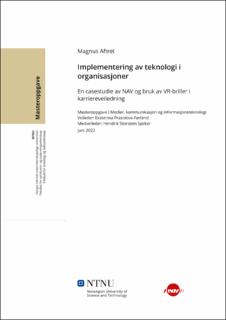| dc.contributor.advisor | Prasolova-Førland, Ekaterina | |
| dc.contributor.advisor | Spilker, Hendrik Storstein | |
| dc.contributor.author | Aftret, Magnus | |
| dc.date.accessioned | 2022-07-28T17:19:36Z | |
| dc.date.available | 2022-07-28T17:19:36Z | |
| dc.date.issued | 2022 | |
| dc.identifier | no.ntnu:inspera:104662308:22439515 | |
| dc.identifier.uri | https://hdl.handle.net/11250/3009050 | |
| dc.description.abstract | Teknologier som drar nytte av virtuelle realiteter er mye omtalt, men de kan sies å ha
hatt et noe langsomt inntog i private husholdninger. Man ser derimot fremveksten av et
større fokus på bruk av VR-teknologi til andre formål. Det er forsket mye på bruk av VR
til læring og utdanning. Denne oppgaven har fokus på VR til læringsformål, men hvor å
gjennomføre oppgaver til fordel for å bli bedre på å løse disse ikke er hovedpoenget.
Derimot fokuserer oppgaven på implementering og bruk av VR-teknologi i
veiledningssituasjoner. Oppgaven er en casestudie av NAV og deres implementering av
VR-briller med tilhørende applikasjoner i veiledning. Gjennom dybdeintervjuer med 8 av
disse undersøkes utviklingen av forholdet mellom teknologi og brukere samt utfordringer
som har oppstått på veien. Det blir identifisert og diskutert noen tekniske utfordringer
ved verktøyet. Installasjonen var vanskelig, og det er noen feil på utstyret under bruk.
Innholdsmessig mangler applikasjonene en felles utforming, i tillegg til veiledning av
brukerne inne i appene. Vanskelighetsgraden er varierende, og den kan gjøres mer
passende ved hjelp av elementer fra spill. Det bør også være en sammenheng mellom
elementene når det gjelder realisme, og det er ønskelig med mer variasjon når det
gjelder arbeidsoppgavene i VR-omgivelsene. Når det gjelder organisatoriske utfordringer
er det ønskelig med ressurser og en større satsning fra høyere hold. Funnene diskuteres
ved hjelp av domestiseringsteori og hvordan teknologi og brukere påvirker hverandre i et
samspill, på veien mot at teknologier eventuelt tillegges meninger og plasseringer i
brukernes hverdagsliv. Oppgaven diskuterer også utfordringer og eventuelle løsninger
ved hjelp av gamification-teori og suksesskriterier for at innovasjoner skal vinne frem i
organisasjoner. Oppgaven konkluderer med at det har vært ulik bruk av verktøyet blant
de ansatte, og hver enkelt har domestisert teknologien på ulikt vis. Verktøyet kan
fungere godt i fremtiden, men det er ulike tanker om hvordan verktøyet bør bli brukt.
Verktøyet er tatt i bruk og delvis domestisert av NAV som organisasjon, men det er en
rekke utfordringer som må løses hvis teknologien skal bli en fullt ut integrert del av
arbeidshverdagen til de ansatte. | |
| dc.description.abstract | Technologies that take advantage of virtual realities are widely discussed, but they can
be said to have had a somewhat slow entry into private households. On the other hand,
one sees the emergence of a greater focus on the use of VR technology for other
purposes. Much research has been done on the use of VR for learning and education. This
thesis focuses on VR for learning purposes, but where to complete tasks in favor of
becoming better at solving problems is not the main point. On the other hand, the thesis
focuses on the implementation and use of VR technology in career guidance. The thesis is
a case study of NAV and their implementation of VR glasses and applications in career
guidance. Through in-depth interviews with 8 of the informants, the development of the
relationship between technology and users is examined, as well as challenges that have
arisen along the way. Some technical challenges with the tool are identified and
discussed. Installation was difficult and there are some errors during use. In terms of
content, the applications lack a common design, in addition to guidance of the users
inside the apps. The degree of difficulty varies, and it can be made more appropriate
using elements from games. There should also be a connection between the elements
when it comes to realism, and it is desirable with more variation when it comes to the
work tasks in the VR sphere. When it comes to organizational challenges, resources and
a greater investment from higher levels are desirable. The findings are discussed with the
help of domestication theory and how technology and users influence each other in an
interaction, on the way to technologies possibly being given meanings and placements in
the users' everyday lives. The thesis also discusses challenges and possible solutions
using gamification theory, along with barriers and success criteria for innovations to win
in organizations. The thesis concludes that there has been a different use of the tool
among the employees, and each individual has domesticated the technology in different
ways. The tool may work well in the future, but there are different thoughts about how
the tool should be used. The tool has been domesticated and partly used by NAV as an
organization, but there are a number of challenges that must be solved if the technology
is to become a fully integrated part of the employees' everyday work. | |
| dc.language | nob | |
| dc.publisher | NTNU | |
| dc.title | Implementering av teknologi i organisasjoner: En casestudie av NAV og bruk av VR-briller i karriereveiledning. | |
| dc.type | Master thesis | |
